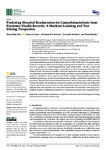Predicting Hospital Readmission for Campylobacteriosis from Electronic Health Records: A Machine Learning and Text Mining Perspective
| dc.contributor.author | Zhou, S-M | |
| dc.contributor.author | Lyons, RA | |
| dc.contributor.author | Rahman, MA | |
| dc.contributor.author | Holborow, A | |
| dc.contributor.author | Brophy, S | |
| dc.date.accessioned | 2022-02-25T13:23:22Z | |
| dc.date.issued | 2022-01-10 | |
| dc.identifier.issn | 2075-4426 | |
| dc.identifier.issn | 2075-4426 | |
| dc.identifier.other | 86 | |
| dc.identifier.uri | http://hdl.handle.net/10026.1/18851 | |
| dc.description.abstract |
<jats:p>(1) Background: This study investigates influential risk factors for predicting 30-day readmission to hospital for Campylobacter infections (CI). (2) Methods: We linked general practitioner and hospital admission records of 13,006 patients with CI in Wales (1990–2015). An approach called TF-zR (term frequency-zRelevance) technique was presented to evaluates how relevant a clinical term is to a patient in a cohort characterized by coded health records. The zR is a supervised term-weighting metric to assign weight to a term based on relative frequencies of the term across different classes. Cost-sensitive classifier with swarm optimization and weighted subset learning was integrated to identify influential clinical signals as predictors and optimal model for readmission prediction. (3) Results: From a pool of up to 17,506 variables, 33 most predictive factors were identified, including age, gender, Townsend deprivation quintiles, comorbidities, medications, and procedures. The predictive model predicted readmission with 73% sensitivity and 54% specificity. Variables associated with readmission included male gender, recurrent tonsillitis, non-healing open wounds, operation for in-gown toenails. Cystitis, paracetamol/codeine use, age (21–25), and heliclear triple pack use, were associated with a lower risk of readmission. (4) Conclusions: This study gives a profile of clustered variables that are predictive of readmission associated with campylobacteriosis.</jats:p> | |
| dc.format.extent | 86-86 | |
| dc.format.medium | Electronic | |
| dc.language | en | |
| dc.language.iso | en | |
| dc.publisher | MDPI | |
| dc.subject | hospitalisation | |
| dc.subject | readmission | |
| dc.subject | Campylobacter infections | |
| dc.subject | machine learning | |
| dc.subject | text mining | |
| dc.subject | feature selection | |
| dc.subject | electronic health records | |
| dc.title | Predicting Hospital Readmission for Campylobacteriosis from Electronic Health Records: A Machine Learning and Text Mining Perspective | |
| dc.type | journal-article | |
| dc.type | Article | |
| plymouth.author-url | https://www.ncbi.nlm.nih.gov/pubmed/35055401 | |
| plymouth.issue | 1 | |
| plymouth.volume | 12 | |
| plymouth.publication-status | Published online | |
| plymouth.journal | Journal of Personalized Medicine | |
| dc.identifier.doi | 10.3390/jpm12010086 | |
| plymouth.organisational-group | /Plymouth | |
| plymouth.organisational-group | /Plymouth/Faculty of Health | |
| plymouth.organisational-group | /Plymouth/Faculty of Health/School of Nursing and Midwifery | |
| plymouth.organisational-group | /Plymouth/REF 2021 Researchers by UoA | |
| plymouth.organisational-group | /Plymouth/REF 2021 Researchers by UoA/UoA03 Allied Health Professions, Dentistry, Nursing and Pharmacy | |
| plymouth.organisational-group | /Plymouth/Users by role | |
| plymouth.organisational-group | /Plymouth/Users by role/Academics | |
| dc.publisher.place | Switzerland | |
| dcterms.dateAccepted | 2021-12-14 | |
| dc.rights.embargodate | 2022-2-26 | |
| dc.identifier.eissn | 2075-4426 | |
| dc.rights.embargoperiod | Not known | |
| rioxxterms.versionofrecord | 10.3390/jpm12010086 | |
| rioxxterms.licenseref.uri | http://www.rioxx.net/licenses/all-rights-reserved | |
| rioxxterms.licenseref.startdate | 2022-01-10 | |
| rioxxterms.type | Journal Article/Review |


